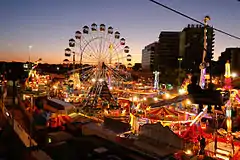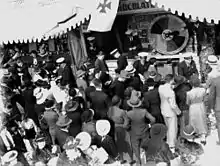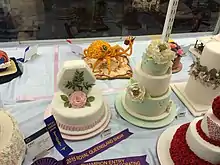Ekka
The Ekka is the annual agricultural show of Queensland, Australia. Its formal title is the Royal Queensland Show, and it is held at the Brisbane Showgrounds. It was originally called the Brisbane Exhibition, but it is more commonly known as the "Ekka", short for "exhibition". It is run by The Royal National Agricultural and Industrial Association of Queensland.
| Royal Queensland Show Ekka | |
|---|---|
 Sideshow Alley viewed at dusk from the John MacDonald stand | |
| Genre | Agricultural Show |
| Frequency | Annual |
| Location(s) | Brisbane, Australia |
| Years active | 141 |
| Inaugurated | 1876 |
| Previous event | 9–18 August 2019 |
| Next event | 2021 |
| Attendance | ~400,000 |
| Organised by | The Royal National Agricultural and Industrial Association of Queensland (RNA) |
| Website | www |
The Ekka is Queensland's largest annual event, which welcomes an average of 400,000 visitors each August.[1] The show welcomes 21,000 competition entries, 10,000 animals, and hours of free family entertainment, including a night program. The Ekka features a sideshow alley, showbag pavilion, and nightly fireworks displays.
The significance of the first exhibition held in 1876 was described by locals as the most important event since the separation of Queensland from New South Wales in 1859.[2]
In 2009 as part of the Q150 celebrations, the Ekka was announced as one of the Q150 Icons of Queensland for its role as an "event and festival".[3]
History
The first show, held between 22 and 26 August 1876, attracted 17,000 visitors.[4] The centrepiece of the grounds was the timber exhibition building which housed 1,700 individual exhibits in total.[2] One of the first popular attractions was a timber bridge built by saw-miller William Pettigrew. The show was a spin-off from the famous International Exhibitions being held in Britain and worldwide dating from the Crystal Palace Exhibition of 1851.
A new grandstand designed by Claude William Chambers was open for the 1906 show.[5] It was later named the John Macdonald stand in recognition of a long-serving member of the Royal National Association. In 1920, the show was visited by the Prince of Wales (who later became King Edward VIII) who was asked and gave permission for the name of the association to change to the Royal National Agricultural and Industrial Association of Queensland.[5]
During a time when the Ekka was still young, the main purpose of the agricultural show, as its name suggests, was to show off many agricultural and industrial exhibits. It was a chance for people to show off newly invented agricultural and industrial devices such as ultra modern ploughing, sowing and harvesting artefacts. Cattle and other farm animals were also exhibited during the show, a practice that remains to this day. The Animal Nursery, which has been running since 1964, features around 500 baby farmyard animals for visitors to meet and greet. Since its opening, the show has only been cancelled thrice,[5] in 1919 throughout the time of the Spanish flu pandemic, where the grounds were employed as temporary hospital wards for the sick, in 1942, due to World War II, and in 2020, due to the 2019-20 coronavirus pandemic.[6]
Location
The Ekka is held in Queensland's capital city, Brisbane, for 10 days each August at the Brisbane Showgrounds in the suburb of Bowen Hills. The Ekka is run by the Royal National Agricultural and Industrial Association of Queensland (RNA). The Ekka is Brisbane's most popular event of any sort, with around 400,000 visitors attending the show in recent years.[1]
The showgrounds covers an area of 22 hectares.[5]
During Ekka, the Exhibition railway line is operational with special trains (some of them historic steam trains) carrying passengers to the Exhibition railway station in the middle of the Brisbane Showgrounds.
Attractions




Attractions at the Ekka include fairground rides, a Side Show Alley, animal parades, woodchopping competitions, agricultural displays and equestrian events.
Showbags are also an integral part of the Ekka experience. Usually containing food items (such as confectionery and novelty items), showbags are sold in the Showbag Pavilion. The contents of the showbags are tested to ensure they comply with safety standards.[7] In 2015, there were 362 different showbags available for visitors to spend their money on and enjoy samples of products. Showbags range from $1, $2 (the famous Bertie Beetle Bag) and up to $108, providing companies the opportunity to offer their merchandise to the public at discounted prices.[8]
Competitions remain at the heart of the Ekka. Since the very first show in 1876, the Ekka has been rewarding and recognising those dedicated to producing the best of the best. The competitions include agricultural products such as livestock, fruit and vegetables, and skills in areas as diverse as farriery and cake decorating.[9][10]
Impact
The Ekka, due to its large attendance, raises a large amount of revenue. Estimates of this number average around the $100 million mark, yet this amount may fluctuate with weather in Brisbane at the time (a particularly wet August may reduce attendance significantly).[11]
Because of the cultural significance of the Ekka, the City of Brisbane holds a Wednesday public holiday known as "People's Day". The Ekka starts on the first Friday in August, except if the first Friday is before 5 August, in which case it starts on the second Friday of August. People's Day is then the Wednesday after the Ekka commences.[12] To avoid overcrowding, some surrounding regions have the public holiday on alternative days.
Ekka Winds
Frequently, in the week leading up to the Ekka, the chilly 'Ekka winds' descend on Brisbane. These are westerly winds caused by high pressure systems in the Great Australian Bight.[13]
References
- "Ekka attracts 400,000 visitors for the third year". Queensland Country Life. 20 August 2012. Archived from the original on 3 April 2013. Retrieved 20 February 2013.
- Scott, Joanne; Ross Laurie (2008). Showtime: A history of the Brisbane Exhibition. Brisbane: University of Queensland Press. pp. 1–4. ISBN 9780702236587.
- Bligh, Anna (10 June 2009). "PREMIER UNVEILS QUEENSLAND'S 150 ICONS". Queensland Government. Archived from the original on 24 May 2017. Retrieved 24 May 2017.
- Mirosch, Natascha. "Ekka food offers a taste of history and source of nostalgia". The Courier-Mail. Archived from the original on 20 September 2008. Retrieved 4 August 2008.
- Gregory, Helen; Dianne Mclay (2010). Building Brisbane's History: Structure, Sculptures, Stories and Secrets. Warriewood, New South Wales: Woodslane Press. pp. 164–170. ISBN 9781921606199.
- "Archived copy". Archived from the original on 6 April 2020. Retrieved 6 April 2020.CS1 maint: archived copy as title (link)
- Witham, Katrina. "Dangerous toy recalled from Ekka showbag". Brisbane Times. Archived from the original on 4 August 2008. Retrieved 4 August 2008.
- "Ekka 2015: Full list of showbags". Courier-Mail. 5 August 2015. Retrieved 9 August 2015.
- "Farriers & Blacksmiths" (PDF). Royal Queensland Show. 2015. Archived from the original (PDF) on 24 September 2015. Retrieved 9 August 2015.
- "Cookery" (PDF). Royal Queensland Show. 2015. Retrieved 9 August 2015.
- Crawford, Fiona (10 August 2007). "Ekka Flu". Australian Broadcasting Corporation. Archived from the original on 8 August 2014. Retrieved 31 July 2014.
- "Public holidays". Queensland Government. Archived from the original on 25 July 2017. Retrieved 25 July 2017.
- "One key difference at this year's show". Retrieved 8 August 2017.
External links
| Wikimedia Commons has media related to Ekka. |
- Official website
- "Brisbane Show photograph album". State Library of Queensland. 1912. hdl:10462/eadarc/6611. Cite journal requires
|journal=(help)